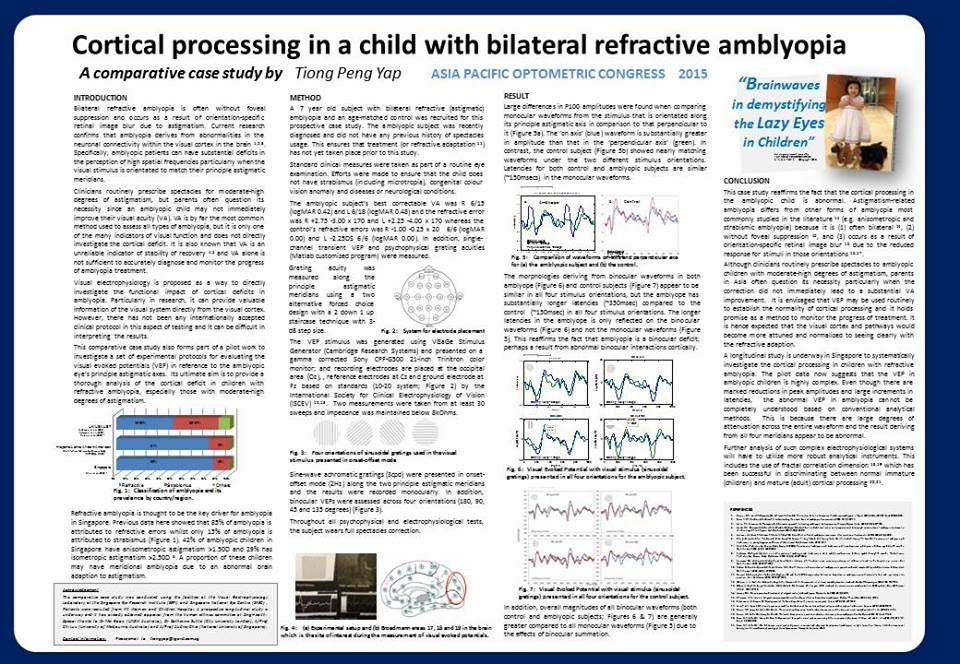Patching for Lazy Eyes
It can be tricky with patching the eyes (in Occlusion Therapy) as it can interfere with daily activities in school (for children), at work (for adults) or at home. Although this might be recommended by your eye doctor, there are other ways to treat amblyopia (lazy eyes). For example, children and adults tends to tolerate better with therapy using Bangerter Filters than patching the eyes like a pirate. This has to be prescribed and dispensed by an optometrist.
In addition, children and adults can also attend vision therapy which utilizes orthoptic and optometric exercises to treat amblyopia and improve binocularity.

A poster presentation at the Asia Pacific Optometric Conference 2015 (Kuala Lumpur, Malaysia) by Yap Tiong Peng Senior Consultant Optometrist, IGARD Group Singapore. By analysing brainwaves (visual electrophysiology or visual evoked potentials), he found that the child with bilateral refractive amblyopia has substantially longer latencies (~350msec) compared to the control subject (~150msec). Binocular waveforms were slightly greater compared to all monocular waveforms due to the effects of binocular summation, but latencies were substantially longer in the binocular waveforms compared to monocular waveforms possibly due to binocular suppression. In summary, he found that abnormal binocular interaction is likely present at the cortical level for the child with bilateral refractive amblyopia and the cortical suppression is orientation-specific to the principle meridians of the child's astigmatism. Cortical deficits was found in the amblyopic child even in the absence of anisometropia and strabismus.
Rate of re-occurrence and abnormal binocularity following strabismus surgery in children (Research study published in the American Journal of Ophthalmology):
Results: Of 11,115 children having strabismus procedures, 851 (7.7%) underwent reoperation. The reoperation rate was 7.4% for fixed suture surgeries, 9.6% for adjustable suture surgeries (p=0.18), and 44.9% for botulinum injections (p<0.001). Age under 2 years was associated with higher reoperation and abnormal binocularity rates (p<0.001). For horizontal strabismus, the postoperative abnormal binocularity rate was 12.8% for fixed suture surgery and 26.5% for botulinum injection (p=0.005). Reoperation rates tended to be higher with adjustable sutures (odds ratio [OR] 1.69, 95% confidence interval [CI] 0.94 to 3.03, p=0.08), or botulinum toxin injection (OR 10.36, 95% CI 5.75 to 18.66, p<0.001) and lower with 3- or 4-muscle surgery (p=0.001). Esotropia, hyperopia, and botulinum injection were independently associated with higher rates of postoperative abnormal binocularity (p<=0.005). For vertical surgeries, predictors of reoperation were adjustable suture use (OR 2.51, p=0.10) and superior oblique surgery (OR 2.36, p<0.001).
http://www.ajo.com/article/S0002-9394(15)00677-7/abstract

Photo: Senior Consultant Optometrists Yap Tiong Peng and Rachel Kelly (IGARD Group Singapore) lectures on the topic Appreciating Vision and Treating Amblyopia. This is part of a series of continuing education courses in Paediatric Optometry produced by IGARD in collaboration with Singapore International Eye Cataract Retina Center.

